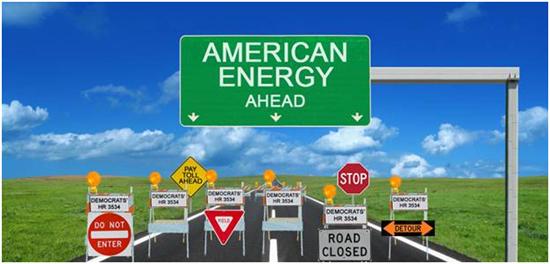
On September 16th, the House Natural Resources Committee will hold its first hearing on the CLEAR Act – a bill that throws up countless roadblocks on the path to American energy production and job creation.
Click here to read Edition #1 of the Democrats’ Roadblock to Energy bill.
 Roadblock #4: Blocking all energy production, including wind and solar, on public land (Sec. 101). Americans wanting to produce renewable energy on public lands better be prepared to stop due to this provision. It will require the Bureau of Land Management and the U.S. Forest Service to develop land use plans “in which energy development would not conflict with other land uses.”
Roadblock #4: Blocking all energy production, including wind and solar, on public land (Sec. 101). Americans wanting to produce renewable energy on public lands better be prepared to stop due to this provision. It will require the Bureau of Land Management and the U.S. Forest Service to develop land use plans “in which energy development would not conflict with other land uses.”
Get the Facts:
- This section makes all-of-the-above energy development, including renewable energy such as wind and solar, the last priority for public land use. Nearly every piece of federal land could be used for recreation, hiking, hunting, fishing or livestock grazing. If energy production can only take place where there are no ‘conflicts’ with other land uses, it would likely never occur on public lands resulting in fewer jobs and less American energy.
- As our country continues to move towards increased use of renewable energy, it makes no sense to put federal lands off limits to production. Unfortunately, this is one more example of Democrats trying to lock up federal land to all-of-the-above energy production.
 Roadblock #5: Creating new “Regional Outer Continental Shelf Strategic Plans” that could prevent new wind, solar, oil and natural gas production on the OCS (Sec. 603). By placing certain zones of the OCS off limits to energy development, these plans could close the road to new energy production and new job creation on the OCS.
Roadblock #5: Creating new “Regional Outer Continental Shelf Strategic Plans” that could prevent new wind, solar, oil and natural gas production on the OCS (Sec. 603). By placing certain zones of the OCS off limits to energy development, these plans could close the road to new energy production and new job creation on the OCS.
Get the Facts:
- This bill contains a provision that would require new Regional Oceans Councils to create Regional Outer Continental Shelf Strategic Plans. (See Roadblock Edition #1)
- For the first time ever, these plans would determine which zones of the OCS could be open or closed to all-of-the-above energy development.
- Many of the plans’ requirements, including “protecting marine ecosystem health,” will likely lead to litigation and be used as reasons to block energy development. For example, many opponents of drilling would argue that it’s impossible to drill offshore while maintaining “marine ecosystem health,” therefore offshore energy production should never take place. This section opens the door for litigation to limit and delay where offshore drilling can occur.
 Roadblock #6: Shutting down American uranium mining that is used for emission-free nuclear energy (Title V – Subtitle B). Uranium production would reach a dead end under that this provision that would make uranium a leasable mineral and impose a 12.5 percent royalty on production.
Roadblock #6: Shutting down American uranium mining that is used for emission-free nuclear energy (Title V – Subtitle B). Uranium production would reach a dead end under that this provision that would make uranium a leasable mineral and impose a 12.5 percent royalty on production.
Get the Facts:
- This bill would deal a devastating blow to American uranium production by making it more expensive and difficult to mine.
- Conducting uranium lease sales will simply delay the development process. Unlike oil and natural gas, uranium deposits are not easily identifiable and figuring out which areas to even include in a lease sale would be a costly and lengthy process.
- Additionally, raising the royalty rate on uranium to a prohibitive 12.5 percent will create disincentives to mine and cost jobs. Today America is 90 percent dependent on uranium from Russia and other countries and this royalty rate will make the U.S. even more foreign dependent.
- Rather than throwing up obstacles, Congress should encourage the development of uranium which is used to produce carbon-free nuclear energy.
# # #
Other Editions in the Series:
- Press Release - Democrats’ Roadblock to Energy Bill: Edition #1 (09/15/09)
- Press Release - Democrats’ Roadblock to Energy Bill: Edition #3 (09/16/09)
Print version of this document



 Roadblock #4: Blocking all energy production, including wind and solar, on public land (Sec. 101). Americans wanting to produce renewable energy on public lands better
Roadblock #4: Blocking all energy production, including wind and solar, on public land (Sec. 101). Americans wanting to produce renewable energy on public lands better  Roadblock #5: Creating new “Regional Outer Continental Shelf Strategic Plans” that could prevent new wind, solar, oil and natural gas production on the OCS (Sec. 603). By placing certain zones of the OCS off limits to energy development, these plans could
Roadblock #5: Creating new “Regional Outer Continental Shelf Strategic Plans” that could prevent new wind, solar, oil and natural gas production on the OCS (Sec. 603). By placing certain zones of the OCS off limits to energy development, these plans could  Roadblock #6: Shutting down American uranium mining that is used for emission-free nuclear energy (Title V – Subtitle B). Uranium production would reach a
Roadblock #6: Shutting down American uranium mining that is used for emission-free nuclear energy (Title V – Subtitle B). Uranium production would reach a